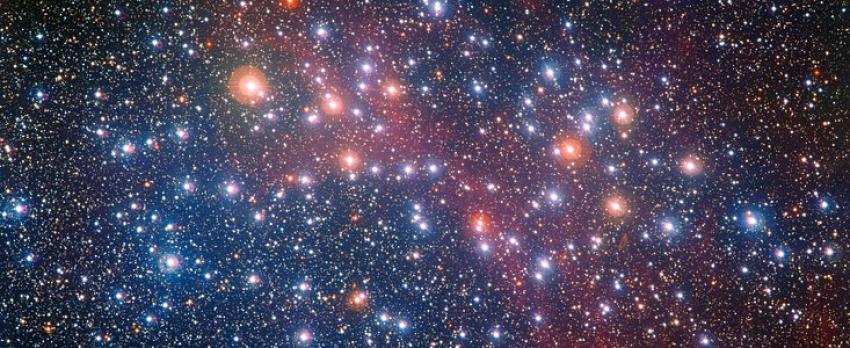Researchers from Keele University have developed a machine learning technique that helps astronomers better estimate the ages of stars from the chemicals within their atmospheres. The new research will be presented at the 2023 National Astronomy Meeting by Keele PhD student George Weaver.
A star’s age is very difficult to determine. Unlike objects such as solar system meteorites or rocks on other planets, it is not possible to gather physical samples to measure the chemical abundances and age of the stars we see in the night sky by radioactive dating. Instead, astronomers need to make estimates based on the light we receive from stars. This is most easily done for large groups of stars which evolve together, known as star clusters, but is much more difficult for single stars.
During the very early stages of a star’s life cycle, the increasing heat and pressure can change the chemical composition of its atmosphere. One major change is that the amount of the element lithium in its atmosphere decreases over time through a process known as ‘lithium depletion’. Current models have not been able to describe the full complexity of this effect.
The large number of high-quality spectra – an analysis of emitted light from an object - obtained from the Gaia-ESO survey means that astronomers can now look at the problem of lithium depletion in much greater depth. The new neural network model, a development of a previous mathematical model known as EAGLES, uses the data from over 6000 stars to model the relationship between a star’s temperature, measured lithium abundance, and age.
The new method is expandable, and work is already underway to include much more data in the model, creating age estimates using as much information as possible. Tests are already underway for a model that includes the metallicity of the stars – the model will take in to account the measure of the amount of elements heavier than helium in the star. Other possible expansions will look at slowing of a star’s rotation over its lifetime, and the decrease in its magnetic activity over time.
PhD student and first author of the paper in preparation, George Weaver explains, “There are several independent age estimation methods and models, but this artificial neural network gives us the chance to create one combined method to estimate a star’s age from spectral measurements.” He adds, “Not only could it lead to a ‘one-stop shop’ model for stellar and cluster ages, but it will also help us to quantify and constrain the relationships between these observables and age, and maybe even discover new relationships we weren’t aware of before.”
Media contacts
Ms Gurjeet Kahlon
Royal Astronomical Society
Mob: +44 (0)7802 877 700
press@ras.ac.uk
Ms Megan Eaves
Royal Astronomical Society
press@ras.ac.uk
Dr Robert Massey
Royal Astronomical Society
Mob: +44 (0)7802 877 699
press@ras.ac.uk
Science contacts
George Weaver
Keele University
g.weaver@keele.ac.uk
Prof. Robin Jeffries
Keele University
r.d.jeffries@keele.ac.uk
Notes for editors
The NAM 2023 conference is principally sponsored by the Royal Astronomical Society (RAS), the Science and Technology Facilities Council (STFC) and Cardiff University.
About the Royal Astronomical Society
The Royal Astronomical Society (RAS, https://ras.ac.uk), founded in 1820, encourages and promotes the study of astronomy, solar-system science, geophysics and closely related branches of science. The RAS organises scientific meetings, publishes international research and review journals, recognises outstanding achievements by the award of medals and prizes, maintains an extensive library, supports education through grants and outreach activities and represents UK astronomy nationally and internationally. Its more than 4,000 members (Fellows), a third based overseas, include scientific researchers in universities, observatories and laboratories as well as historians of astronomy and others.
Follow the RAS on Twitter (https://twitter.com/royalastrosoc), Facebook (https://facebook.com/royalastrosoc), Instagram (https://instagram.com/royalastrosoc) and YouTube (https://www.youtube.com/channel/UCUZJ5FO9ayrmepOM4FHAASw)
About the Science and Technology Facilities Council
The Science and Technology Facilities Council (STFC) is part of UK Research and Innovation – the UK body which works in partnership with universities, research organisations, businesses, charities, and government to create the best possible environment for research and innovation to flourish. STFC funds and supports research in particle and nuclear physics, astronomy, gravitational research and astrophysics, and space science and also operates a network of five national laboratories, including the Rutherford Appleton Laboratory and the Daresbury Laboratory, as well as supporting UK research at a number of international research facilities including CERN, FERMILAB, the ESO telescopes in Chile and many more.
STFC's Astronomy and Space Science programme provides support for a wide range of facilities, research groups and individuals in order to investigate some of the highest priority questions in astrophysics, cosmology and solar system science. STFC's astronomy and space science programme is delivered through grant funding for research activities, and also through support of technical activities at STFC's UK Astronomy Technology Centre and RAL Space at the Rutherford Appleton Laboratory. STFC also supports UK astronomy through the international European Southern Observatory and the Square Kilometre Array Organisation.
Visit https://stfc.ukri.org/ for more information.
Follow STFC on Twitter: @STFC_Matters
About Cardiff University
Cardiff University is recognised in independent government assessments as one of Britain’s leading teaching and research universities and is a member of the Russell Group - the UK’s most research intensive universities. The 2021 Research Excellence Framework found 90% of the University’s research to be world-leading or internationally excellent. Among its academic staff are two Nobel Laureates, including the winner of the 2007 Nobel Prize for Medicine, Professor Sir Martin Evans. Founded by Royal Charter in 1883, today the University combines impressive modern facilities and a dynamic approach to teaching and research. The University’s breadth of expertise encompasses: the College of Arts, Humanities and Social Sciences; the College of Biomedical and Life Sciences; and the College of Physical Sciences and Engineering. Its University institutes bring together academics from a range of disciplines to tackle some of the challenges facing society, the economy, and the environment. More at www.cardiff.ac.uk


